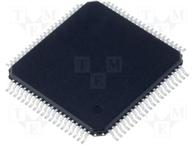●General description
●The LPC1759/58/56/54/52/51 are ARM Cortex-M3 based microcontrollers for embedded applications featuring a high level of integration and low power consumption. The ARM Cortex-M3 is a next generation core that offers system enhancements such as enhanced debug features and a higher level of support block integration.
●The LPC1758/56/57/54/52/51 operate at CPU frequencies of up to 100 MHz. The LPC1759 operates at CPU frequencies of up to 120 MHz. The ARM Cortex-M3 CPU incorporates a 3-stage pipeline and uses a Harvard architecture with separate local instruction and data buses as well as a third bus for peripherals. The ARM Cortex-M3 CPU also includes an internal prefetch unit that supports speculative branching.
●Features and benefits
●■ ARM Cortex-M3 processor, running at frequencies of up to 100 MHz
● (LPC1758/56/57/54/52/51) or of up to 120 MHz (LPC1759). A Memory Protection Unit
● (MPU) supporting eight regions is included.
●■ ARM Cortex-M3 built-in Nested Vectored Interrupt Controller (NVIC).
●■ Up to 512 kB on-chip flash programming memory. Enhanced flash memory accelerator enables high-speed 120 MHz operation with zero wait states.
●■In-System Programming (ISP) and In-Application Programming (IAP) via on-chip bootloader software.
●■ On-chip SRAM includes:
●♦ Up to 32 kB of SRAM on the CPU with local code/data bus for high-performance CPU access.
●♦ Two/one 16 kB SRAM blocks with separate access paths for higher throughput.
●■ These SRAM blocks may be used for Ethernet (LPC1758 only), USB, and DMA memory, as well as for general purpose CPU instruction and data storage.
●■ Eight channel General Purpose DMA controller (GPDMA) on the AHB multilayer matrix that can be used with the SSP, I2S-bus, UART, the Analog-to-Digital and Digital-to-Analog converter peripherals, timer match signals, and for memory-to-memory transfers.
●■ Multilayer AHB matrix interconnect provides a separate bus for each AHB master. AHB masters include the CPU, General Purpose DMA controller, Ethernet MAC (LPC1758 only), and the USB interface. This interconnect provides communication with no arbitration delays.
●■ Split APB bus allows high throughput with few stalls between the CPU and DMA.
●■ Serial interfaces:
● ♦ On the LPC1758 only, Ethernet MAC with RMII interface and dedicated DMA controller.
● ♦ USB 2.0 full-speed device/Host/OTG controller with dedicated DMA controller and on-chip PHY for device, Host, and OTG functions. The LPC1752/51 include a USB device controller only.
● ♦ Four UARTs with fractional baud rate generation, internal FIFO, and DMA support. One UART has modem control I/O and RS-485/EIA-485 support, and one UART has IrDA support.
● ♦ CAN 2.0B controller with two (LPC1759/58/56) or one (LPC1754/52/51) channels.
● ♦ SPI controller with synchronous, serial, full duplex communication and programmable data length.
● ♦ Two SSP controllers with FIFO and multi-protocol capabilities. The SSP interfaces can be used with the GPDMA controller.
● ♦ Two I2C-bus interfaces supporting fast mode with a data rate of 400 kbit/s with multiple address recognition and monitor mode.
● ♦ On the LPC1759/58/56 only, I2S (Inter-IC Sound) interface for digital audio input or output, with fractional rate control. The I2S-bus interface can be used with the GPDMA. The I2S-bus interface supports 3-wire and 4-wire data transmit and receive as well as master clock input/output.
●■ Other peripherals:
● ♦ 52 General Purpose I/O (GPIO) pins with configurable pull-up/down resistors. All GPIOs support a new, configurable open-drain operating mode. The GPIO block is accessed through the AHB multilayer bus for fast access and located in memory such that it supports Cortex-M3 bit banding and use by the General Purpose DMA Controller.
● ♦ 12-bit Analog-to-Digital Converter (ADC) with input multiplexing among six pins, conversion rates up to 200 kHz, and multiple result registers. The 12-bit ADC can be used with the GPDMA controller.
● ♦ On the LPC1759/58/56/54 only, 10-bit Digital-to-Analog Converter (DAC) with dedicated conversion timer and DMA support.
● Four general purpose timers/counters, with a total of three capture inputs and ten compare outputs. Each timer block has an external count input. Specific timer events can be selected to generate DMA requests.
● ♦ One motor control PWM with support for three-phase motor control.
● ♦ Quadrature encoder interface that can monitor one external quadrature encoder.
● ♦ One standard PWM/timer block with external count input.
● ♦ Real-Time Clock (RTC) with a separate power domain and dedicated RTC oscillator. The RTC block includes 20 bytes of battery-powered backup registers.
● ♦ WatchDog Timer (WDT). The WDT can be clocked from the internal RC oscillator, the RTC oscillator, or the APB clock.
● ♦ ARM Cortex-M3 system tick timer, including an external clock input option.
● ♦ Repetitive Interrupt Timer (RIT) provides programmable and repeating timed interrupts.
● ♦ Each peripheral has its own clock divider for further power savings.

 Part 3D Model
Part 3D Model
